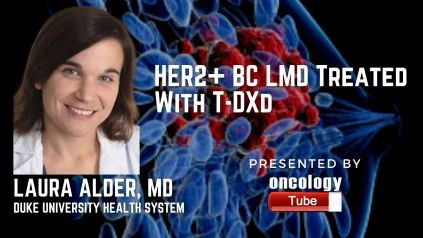Laura Alder, MD, Hematology-Oncology Fellow at Duke University Health System. In this video, she speaks about the AACR 2022 Abstract 5257 – Durable clinical and radiographic responses in a series of patients with HER2+ Breast Cancer (BC) Leptomeningeal Disease (LMD) treated with trastuzumab deruxtecan (T-DXd).
Outline
Â
Origins:
Â
LMD is a catastrophic clinical consequence of metastatic breast cancer, with a 4.4-month median survival for the HER2+ subtype. There are few effective LMD therapies. T-DXd shown excellent extracranial effectiveness in the DESTINY-Breast01/03 trials for metastatic HER2+ breast cancer, including stable brain metastases (BrM) subgroups. T-effectiveness DXd’s in HER2+ untreated BrM and LMD is uncertain. We provide a case study of six individuals with HER2+ LMD who were treated with T-DXd.
Â
Methodologies:
Â
At Duke Cancer Institute and Dana Farber Cancer Institute, six patients with HER2+ BC with LMD (based on imaging +/- positive cytology) who had received T-DXd before to 10/18/21 and had undergone at least one restaging examination were found. Data was collected from patients’ electronic medical records and placed into a secure, patient-anonymized database. Neuroimaging with definitive improvement verified by neuroradiologist evaluation without symptoms of clinical progression was regarded as an objective MRI response. Clinical benefit (CB) is defined as stable disease or an objective response by neuroimaging that does not lead to clinical progression.
Â
Outcomes:
Â
The median age of the 6 patients included was 42.5 years, with 5 median lines of prior therapy. CB was obtained in all six patients (100%) and 5/6 (83.3%) had an objective response on MRI. Patients were given a total of 6.5 (5-23) cycles of treatment. T-DXd therapy lasted a median of 5.3 months (4.1-16.9), with 4/6 patients having continued treatment. The median survival time from LMD diagnosis to death or last follow-up was 12.5 months.
Â
Summary of findings:
Â
In this case series, 5/6 patients exhibited radiographic responses without clinical progression, with a median treatment duration of nearly 6 months and 4/6 patients still receiving T-DXd at the data cutoff. This series explains why T-DXd should be evaluated prospectively in HER2+ LMD patients of various tumor types.

